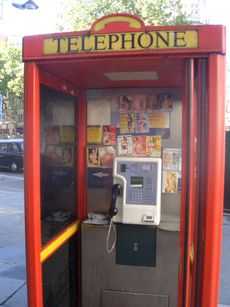Tart card

Tart cards are cards advertising the services of prostitutes. They are found in many countries, usually in capital cities or red-light districts. The cards originated in the 1960s as handwritten postcards outside prostitutes' flats in places such as Soho, London, where they often contained euphemistic references to sex. By the late 1980s they had become black-and-white photocopied cards containing printed text and telephone numbers.[1] In later years they appeared in colour and included photographs and mobile telephone numbers or websites.[2] Over time they have become regarded as items of 'accidental art' and developed a cult following. They have influenced the work of mainstream artists, inspiring collections, research,[3] exhibitions[4][5] and books.
Tart cards by country

- United Kingdom: in London they are placed in phone booths[6] by professional "carders", who tour the phone booths, replacing cards which have been removed by the telephone companies' cleaners. Carders often remove cards placed by rival carders. In the UK, placing them in phone booths has been illegal since the passing of the Criminal Justice and Police Act 2001, although the practice still continues.[7] In Northwest England the cards are known as slag tags.
- United States: In hispanophone parts of New York City they are known as "Chica Chica" (Girls Girls) cards and men hand them out as flyers at night on the streets.[8] In Las Vegas they are known as "sex cards" and left on sidewalks and hotel stairways.[9]
- Argentina: They are found in Buenos Aires.[10]
- Brazil: They are found in São Paulo.[11]
- South Korea: They may be found on the streets and in the public men's toilets of Seoul.
- Poland: Carders place them behind windscreen wipers in the central parts of Warsaw.
- Israel: Business card format advertisements are commonly dropped on street corners in Tel Aviv.
- China: Business cards are given out by pimps to potential customers.
- Macau: They are dropped in the city's sidewalks and underpasses.[12]
- Dubai: Cards advertising "massage" services, often printed with images of scantily-clad young East Asian women, are slipped under front doors or car windows[13]

References
- ↑ "17 Boxes of Smut From The Euston Road". Londonist. Retrieved 18 July 2014.
- ↑ Russell Dornan (21 March 2014). "Putting the art into "tart"". The Wellcome Collection Blog.
- ↑ "The Typographic Hub: Tart Cards". Birmingham Institute of Art & Design. Retrieved 18 July 2014.
- ↑ "Tart Cards Exhibition". Plymouth College of Art. 9–27 January 2012. Retrieved 18 July 2014.
- ↑ "Sex Issue: Type Tart Cards". Wallpaper. Retrieved 18 July 2014.
- ↑ "Crackdown on telephone box 'tartcards'". PA News. 16 May 1999.
- ↑ Archer, Caroline; Clayton, Rob (2003). Tart Cards: London's Illicit Advertising Art. Mark Batty. ISBN 9780972424042.
- ↑ Kenneth Lovett (27 March 2011). "'Chica Chica' cards pimp hookers and prostitution, says state senator who wants to make them illegal". NY Daily News. Retrieved 23 August 2014.
- ↑ Russel, Sabin (29 June 2003). "'Just Say No' – to sex – hits Las Vegas". San Francisco Chronicle. p. 46.
- ↑ "Goodbye to the public telephone: only half are left and rarely used" (in Spanish). Clarín. 7 February 2009.
- ↑ Kanno, Maurício (1 February 2010). "Prostitutes and their adverts are coming to Twitter" (in Portuguese). Folha Online.
- ↑ Katie Hunt (18 June 2013). "The dark side of Asia's gambling Mecca". CNN. Retrieved 15 August 2014.
- ↑ Mariam M. Al Serkal (14 May 2014). "Massage cards menace continues in Dubai". Gulf News. Retrieved 7 December 2014.
Books and magazines
- Vice Art: An Anthology of London's Prostitute Cards, Patrick Jewell, Broadwater House Publisher, 1993 (ISBN 0952100940)
- The X-Directory: Kink Cards 1984/1994, edited by Tony Devlin. Pi34 Publisher, 1994. (ISBN 1898760004)
- Tart Cards: London’s Illicit Advertising Art, Caroline Archer and Rob Clayton, Mark Batty Publisher, 2003. (ISBN 978-0972424042)
- Tart Cards, Caroline Archer, Baseline magazine issue 40, edited by Mike Daines & Hans Dieter Reichert, Bradbourne Publishing, 2003.